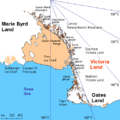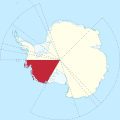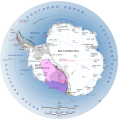Transantarctic Mountains
The Transantarctic Mountains are a mountain range in Antarctica, extending with some interruptions between Cape Adare in Victoria Land and Coatsland.
· 
Adare Peninsula with Cape Adare
· 
Location of the Victoria Land
The mountain range crosses the entire continent of Antarctica between the west coast of the Ross Sea and the east coast of the Weddell Sea, hence the name. It reaches heights of over 4500 m. The ridge, which is between 100 and 300 km wide, forms the border between East Antarctica and West Antarctica over long stretches. The peaks of the mountain range are some of the few places where the ice sheet covering the continent is broken. However, the Transantarctic Mountains are not exposed everywhere, but are completely covered by the ice sheet in places. A special Antarctic phenomenon are the dry valleys near McMurdo Station: These are areas that are free of snow and ice because there is practically no precipitation in them.
With a length of about 3500 km, the Transantarctic Mountains are the fifth longest mountain range on earth. Partly the mountains of the Antarctic Peninsula are added; then a total length of about 4800 km results. The highest mountain is the 4528 m high Mount Kirkpatrick.
The Transantarctic Mountains are considerably older than other mountain ranges on the continent that are volcanic in origin (although the mountains themselves also have some volcanic components). Its folding began about 65 million years ago in the Cenozoic era. The mountains are mainly composed of sandstones and dolerites, some of which were formed more than 400 million years ago (from the Silurian onwards). The mountains, which are not under ice, fossils and geological drillings (e.g. in the Cape Roberts Project) have helped scientists to learn more about the formation history of the Antarctic continent and its central role in the primeval continent of Gondwana.
The name "Transantarctic Mountains" was recommended in 1962 by the Antarctic Names Advisory Committee of the U.S. Geographic Names Board. This purely descriptive name (unlike many other geographic names of the sixth continent, which often honor famous people) is now internationally recognized.
Geographical breakdown
- Mountains of Victoria Land
- Prince Albert Mountains
- Queen Alexandra Range
- Queen Maud Mountains
- Horlick Mountains
- Thiel Mountains
- Pensacola Mountains
Geology
· 
Location of Marie Byrd Land
· 
Map of the Antarctic Peninsula
· 
Antarctic ice shelves with the Ross Ice Shelf marked in red
· 
Location and extent of the West Antarctic Rift System
· .svg.png)
Map of the West Antarctic Rift
· 
Tectonic principles of the West Antarctic Rift System and Transantarctic Mountains
The Transantarctic Range consists of a basement formed by rocks of the Ross orogen and overlying supracrustal sequences of the Beacon Supergroup. Geologically, the range represents the world's longest flank of a rift-fracture system. The latter was formed as a result of crustal reactivation along the East Antarctic craton margin where the Ross orogen had formed. The thermo-tectonic history can be traced back to the Late Jurassic. Apatite fission track dating allowed the delineation of time periods and patterns of exhumation events that occurred from the Early Cretaceous to the Cenozoic.
The opening of the West Antarctic Rift System played a major role in this. This consists of a series of rift valleys between East and West Antarctica. It includes the Ross Embayment, the Ross Sea, the area under the Ross Ice Shelf, part of Marie Byrd Land, and extends to the base of the Antarctic Peninsula. It has an estimated length of about 3000 kilometers and a width of about 700 kilometers. Its development is due to the thinning of the lithosphere between East and West Antarctica. It began in the early to mid-Cretaceous and is associated with the separation of Proto-Ostantarctica from Proto-Australia.
In the Late Cretaceous around 65 mya, the main phase of crustal extension and thinning followed, producing shallow extensional faults on the continental margin. These processes spread further south in the early Cenozoic with ocean floor spreading from the Adare Trough into the continental crust beneath the western Ross Sea. They were probably the triggers for flexural uplift (see also → Flexure) of the East Antarctic lithosphere and hence for the formation of the Transantarctic Mountains, which were uplifted between 7 and 10 kilometres. This thus represents a mountain range that did not form as a result of converging lithospheric plates. This upward movement is currently still continuing.
Search within the encyclopedia